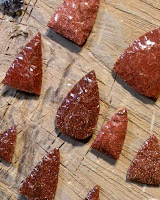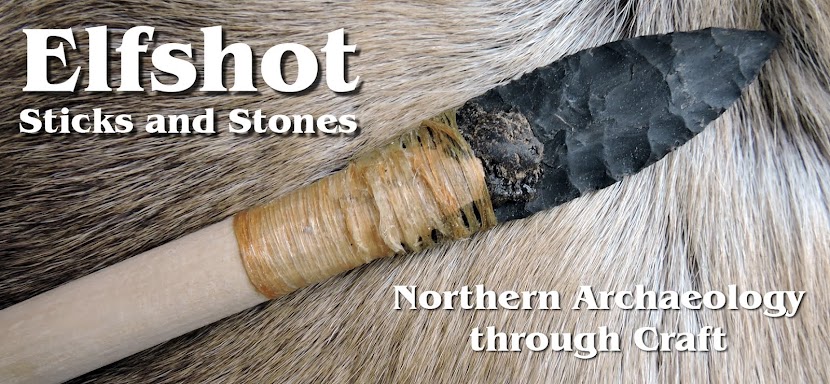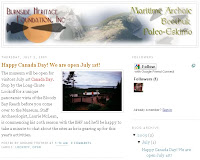
Stephen Eli Harris over at the
Newfoundland and Labrador Blogroll named this site as the Blog of the Week for July 5-11, 2009. A
blogroll is a collection of themed blogs that can be displayed as a list on your side bar. In this case the theme is our Province and you can check out other sites from
Newfoundland and Labrador by scrolling down this page until you spot the
NL flag.
Red Ochre is a naturally
occurring iron oxide that people around the world have used as a pigment for thousands of years.
Newfoundland was no exception. Many
outport buildings were painted with an inexpensive, protective coat of red ochre mixed with oil. But the European fishermen weren't the first or the most famous red ochre users in the Province.
The
Beothuk covered themselves and all their belongings with red ochre. It had an important spiritual
significance to them and helped identify them as a group. Over the thousand or more years that the
Beothuk and their ancestors lived on the Island of
Newfoundland they shared the shores with Inuit and
Innu in the North,
Palaeoeskimos and Indians from southern Quebec, the Norse, French, English, Irish, Basque and
Mi'kmaq.

The first use of the term "Red Indian" was a description of the
Beothuk's practice of covering their bodies with Red Ochre. Painting your body to identify that you belong to a particular group is still alive and well.
The caribou grease that the
Beothuk mixed with the pigment, would have provided some protection from insects in the summer and help insulate the skin in the winter. Have you ever noticed the folks swimming across the English Channel slathering their skin with grease? Its the same idea.

I collect red ochre from Ochre Pit Cove. I don't know if there is any evidence for aboriginal use of the ochre from this community, but it is a good match for the ochre that you see on
Beothuk artifacts. Sometimes its a wonder that the
Beothuk covered all of their belongings as well as their bodies with red ochre. But as Lori will attest to, if you have one thing in your house covered in red ochre, then everything in your house is covered in red ochre. Red ochre is one of the most gregarious pigments I've ever come across. Its not hard to tell the days that I'm working with ochre, it leaves a telltale trail on my clothes, doorknobs, and face cloths throughout the house.

When
Jowi Taylor was putting together the
Six String Nation guitar from bits and pieces of
Canadiana, like Gretzky's hockey stick and Trudeau's canoe paddle, he chose Red Ochre from Ochre Pit Cove to represent the Province of
Newfoundland and Labrador and stain the maple leaf pick guard. Over the years that stain has been wearing off onto the fingers and picks of the hundreds of musicians across the country who played the guitar. Like I said, if you have red ochre on
one thing in your house, you have red ochre on
everything in your house.
Photo Credits:Top, Middle Left: Tim
RastMiddle Right: Leader PostBottom: Six String Nation WebsitePhoto Captions:Top: Beothuk Combs stained with Red Ochre on display in The Rooms, St. John's
Middle Right:
Saskatchewan Roughrider Fans
demonstrating Rider Pride through body painting
Middle Left: The cliff at Ochre Pit Cove where I collect my ochre. The scree slope at the bottom of the cliff naturally sorts the ochre into different sized grains.
Bottom: The Six String Nation Guitar, showing the wear on the Ochre Stain.
Incidentally, the wood its staining is a piece from
James Naismith's childhood home.
 After the visit to the Rooms at the start of the week, most of my work on the Parks contract has been sourcing raw materials and background reading on bows and bowmaking.
After the visit to the Rooms at the start of the week, most of my work on the Parks contract has been sourcing raw materials and background reading on bows and bowmaking. This is the end of the first quarter of the fiscal year so it was a lot of money talk. We're using a new method for budgeting which makes it easier for us to plan ahead for the rest of the year, rather than just wondering over what has already happened.
This is the end of the first quarter of the fiscal year so it was a lot of money talk. We're using a new method for budgeting which makes it easier for us to plan ahead for the rest of the year, rather than just wondering over what has already happened. Until Monday, here's some Elfshot content that might interest you. A pair of a 2005 articles in .pdf format by Alaric Hall; the first from the Journal Folklore called, Getting Shot of Elves: Healing, Witchcraft, and Faeries in the Scottish Witchcraft Trials and a second from Neuphilologische Mitteilungen: Bulletin of the Modern Language Society called, Calling the shots: the Old English remedy gif hors ofscoten sie and Anglo-Saxon "elf-shot".
Until Monday, here's some Elfshot content that might interest you. A pair of a 2005 articles in .pdf format by Alaric Hall; the first from the Journal Folklore called, Getting Shot of Elves: Healing, Witchcraft, and Faeries in the Scottish Witchcraft Trials and a second from Neuphilologische Mitteilungen: Bulletin of the Modern Language Society called, Calling the shots: the Old English remedy gif hors ofscoten sie and Anglo-Saxon "elf-shot".







































